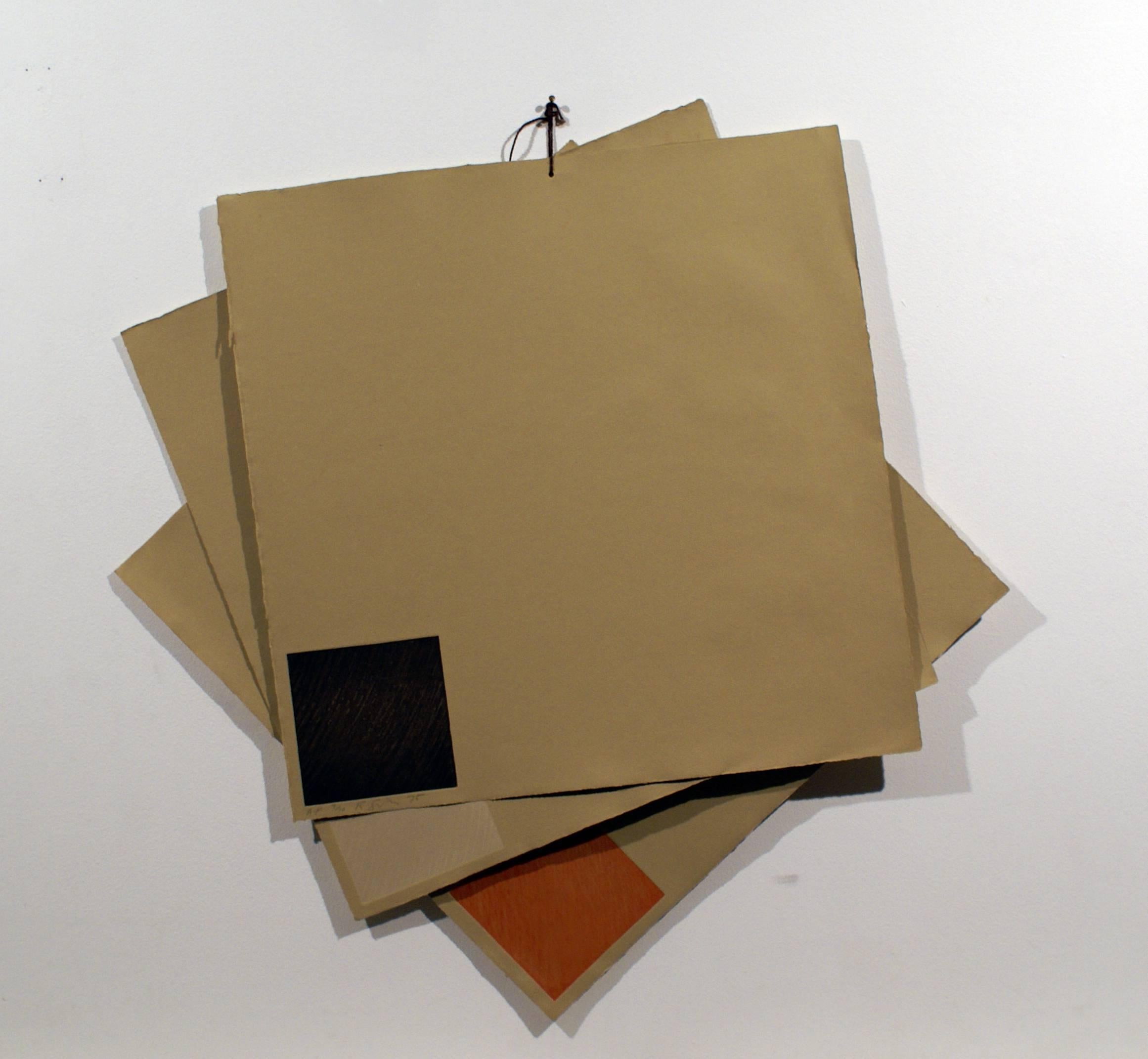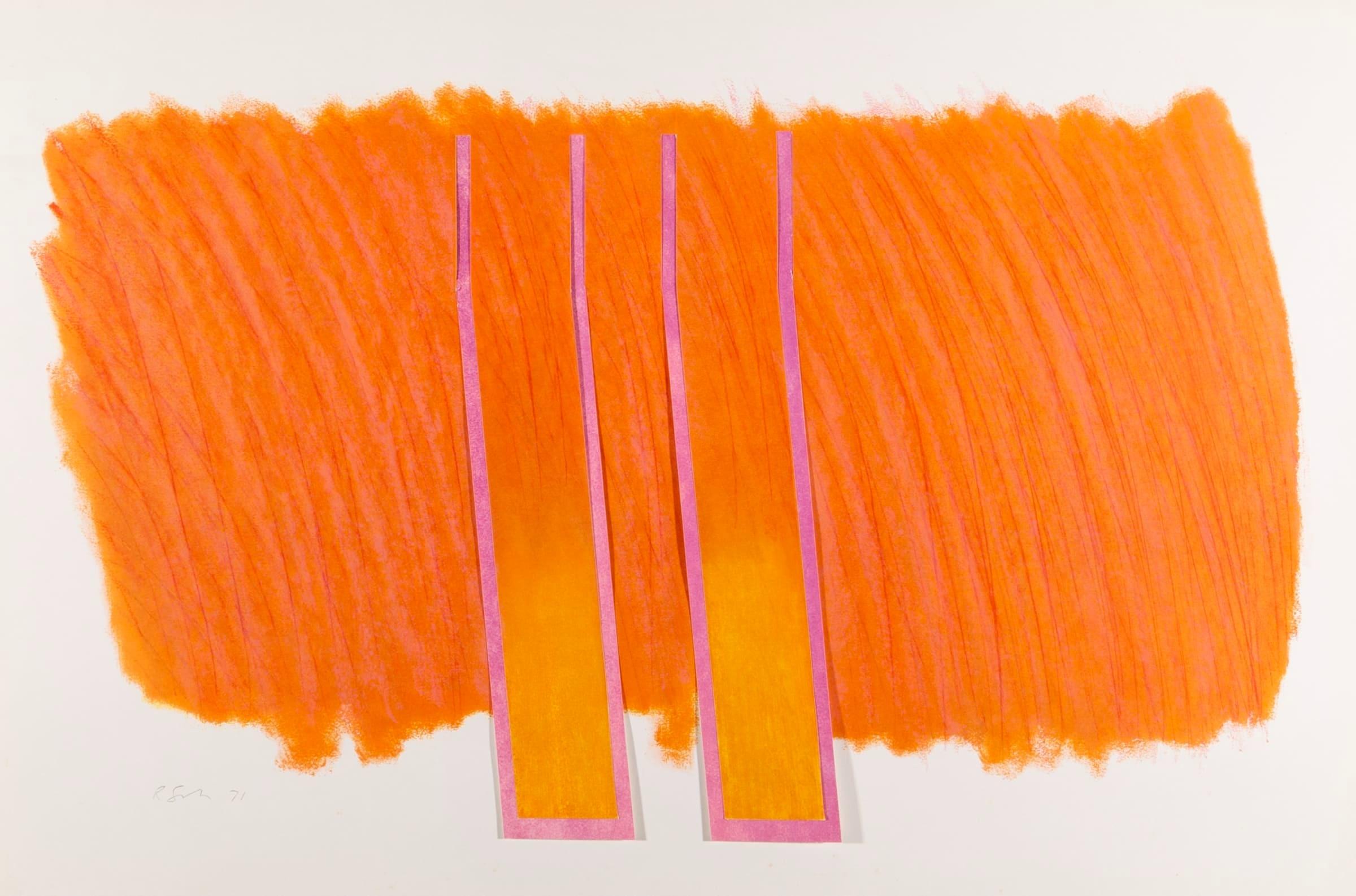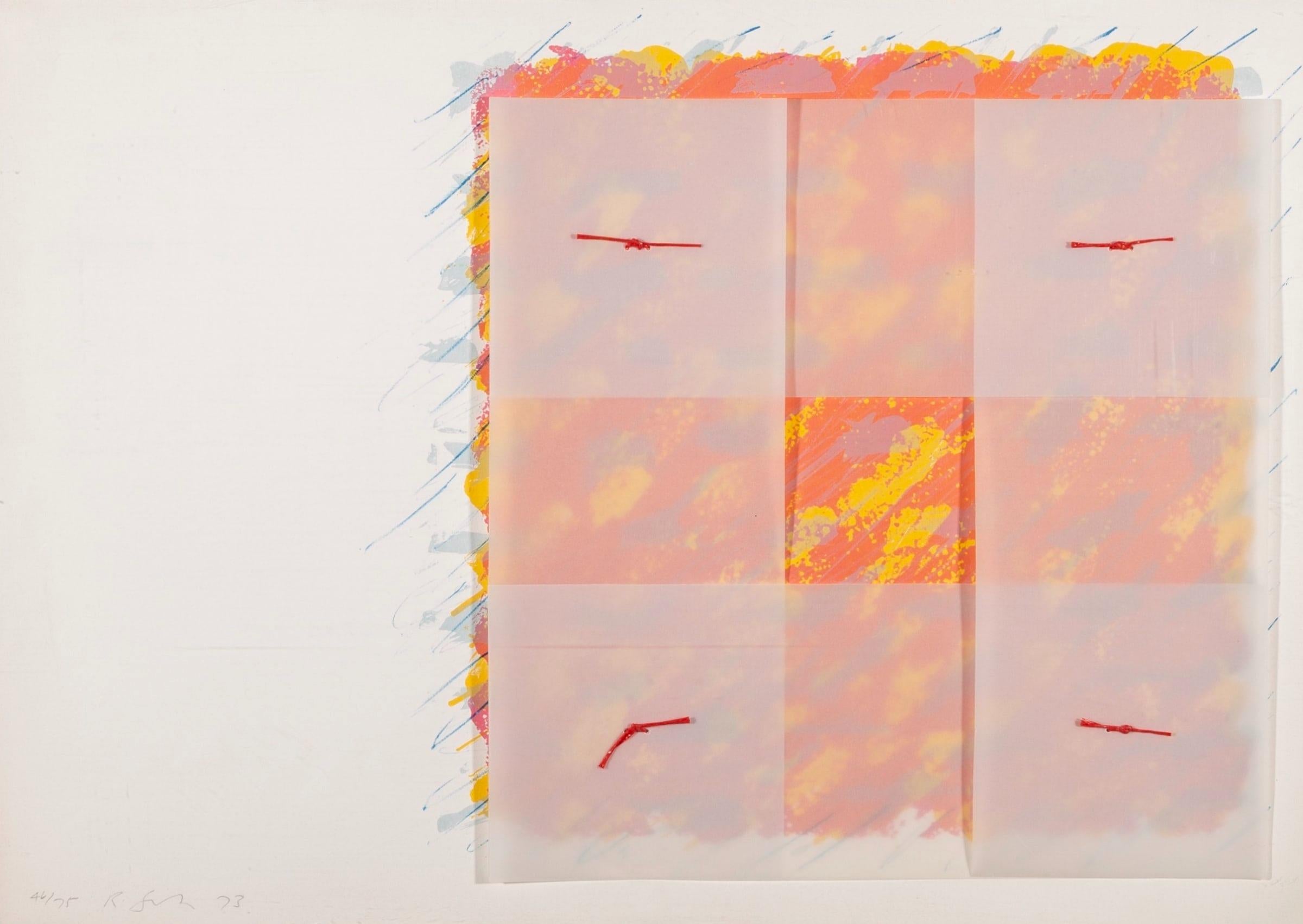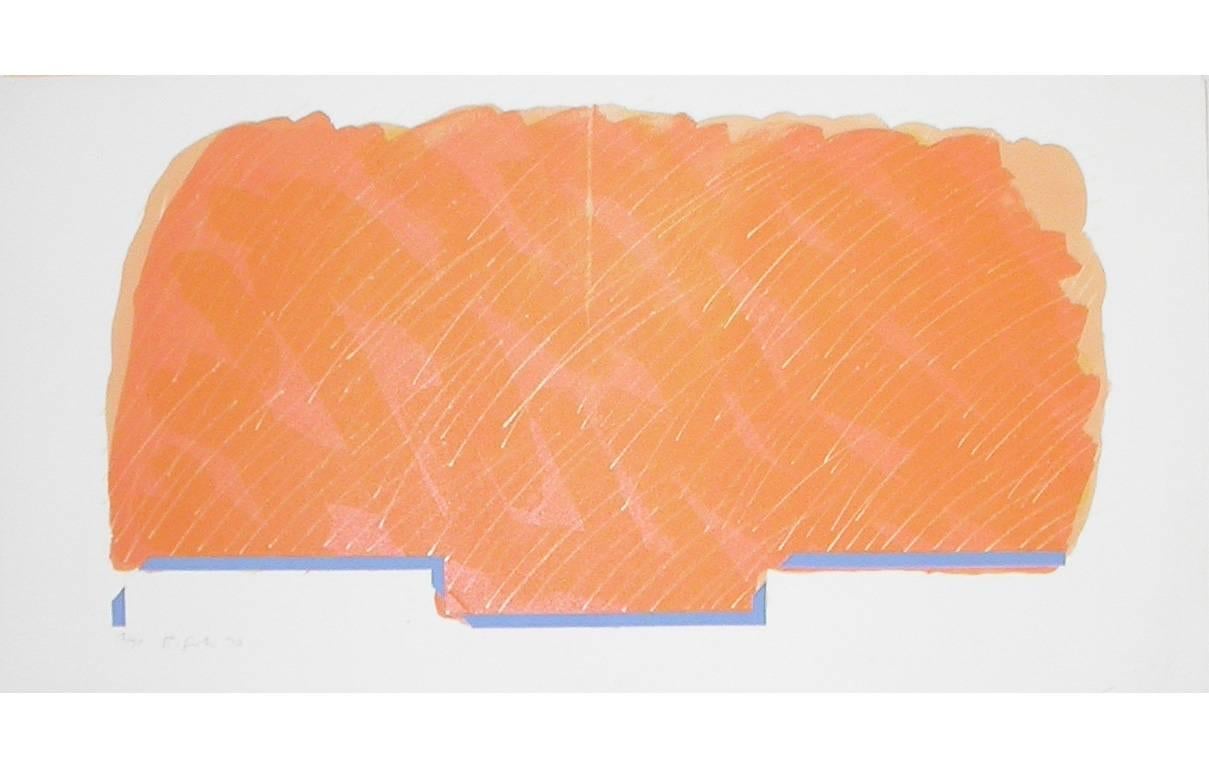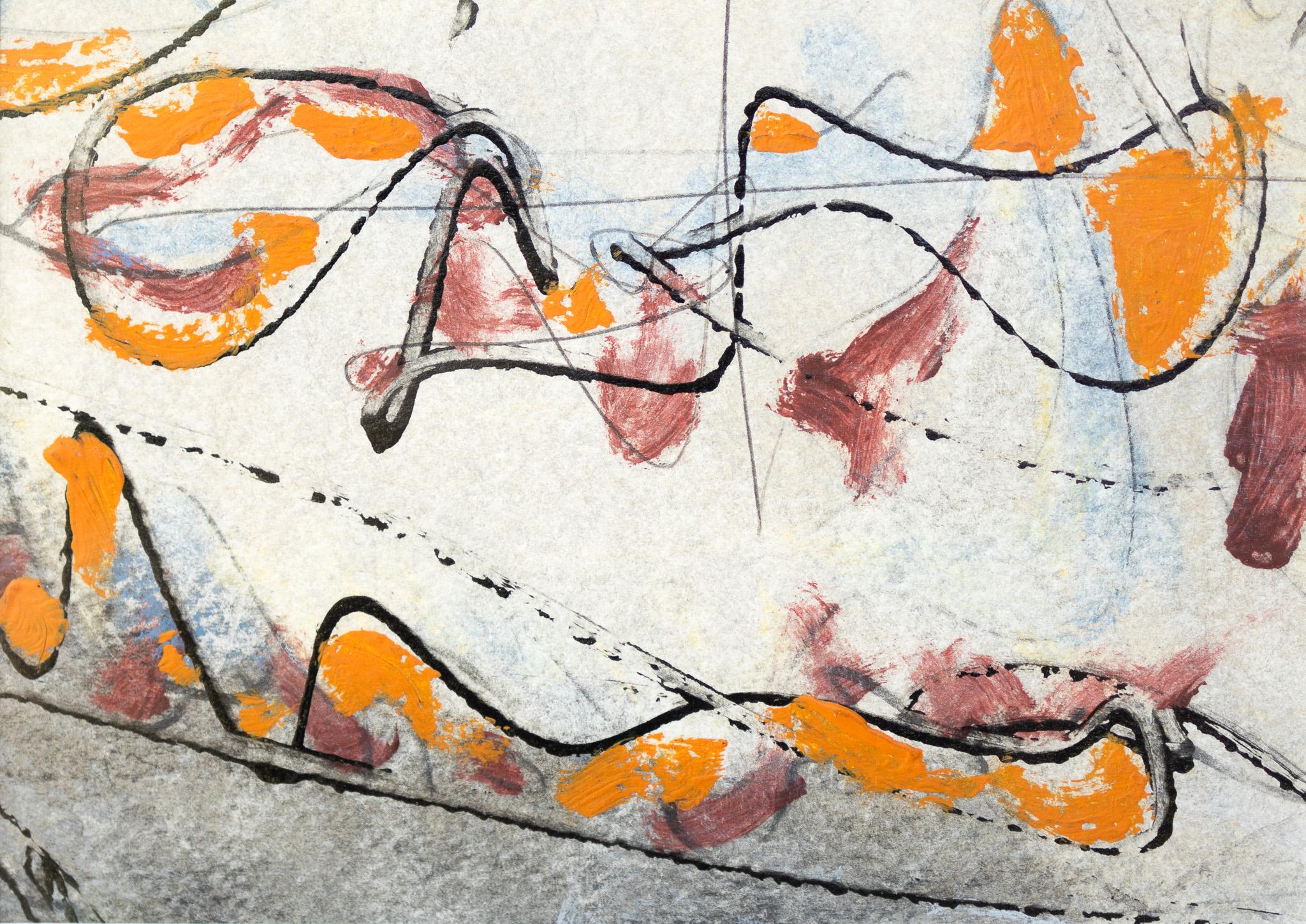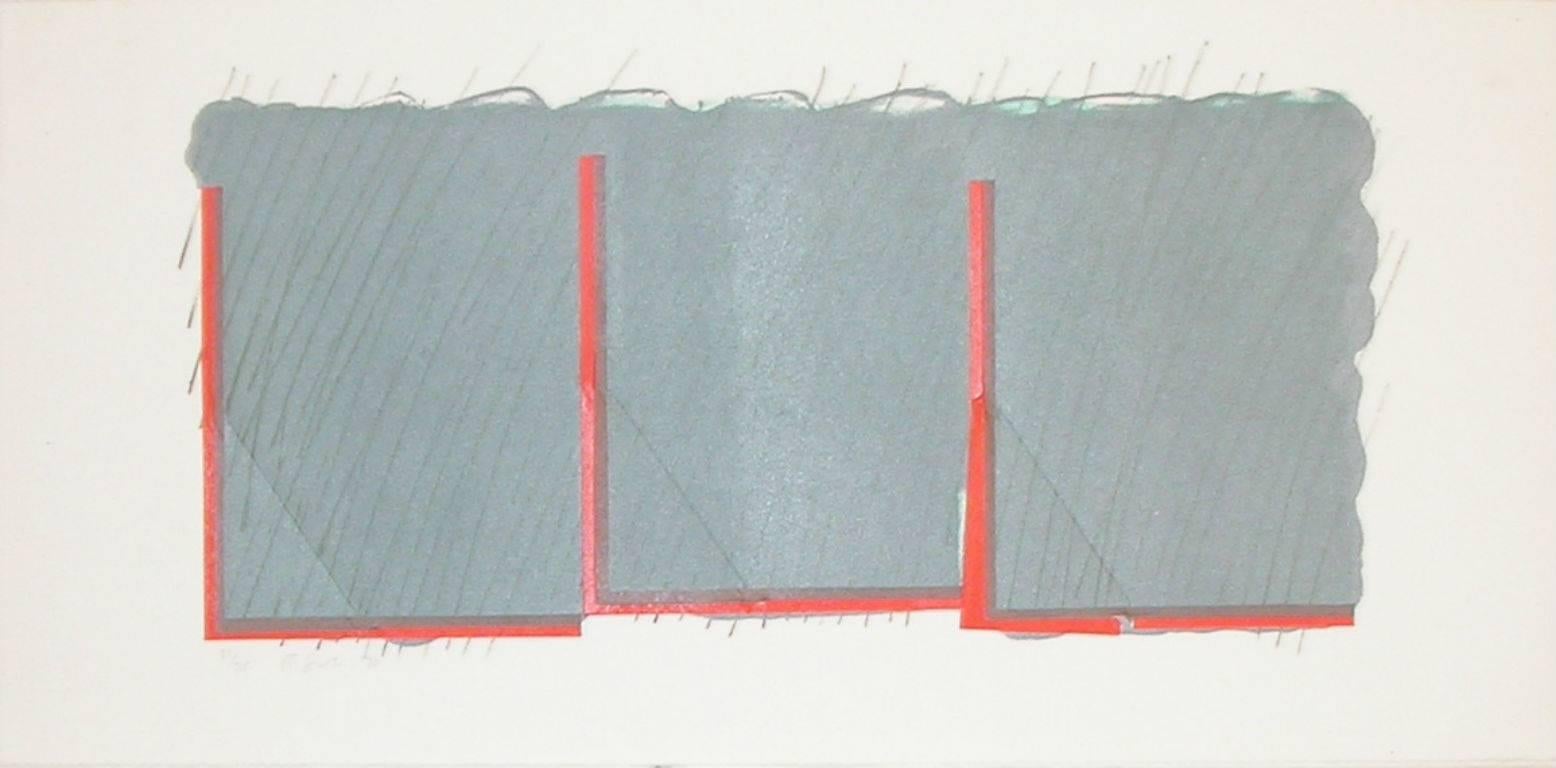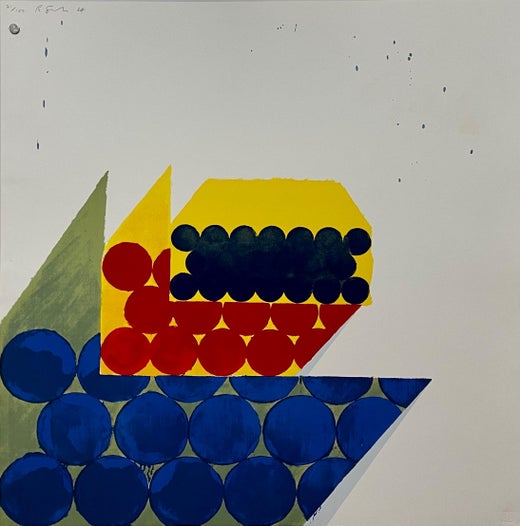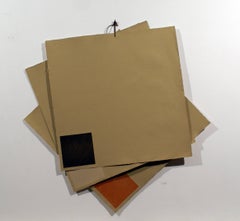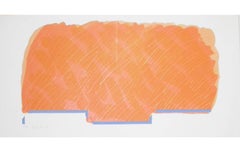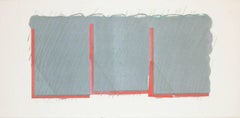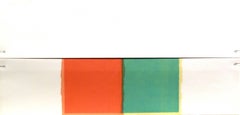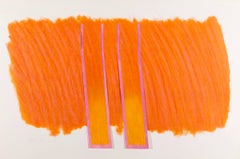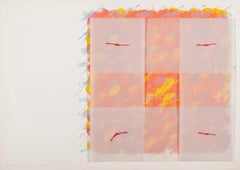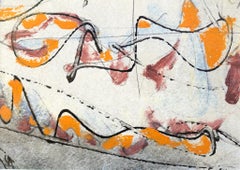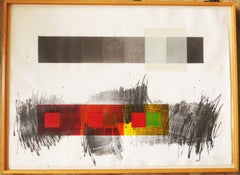Items Similar to Florentine I (red/orange)
Want more images or videos?
Request additional images or videos from the seller
1 of 5
Richard SmithFlorentine I (red/orange)1973
1973
$1,300
£1,009.11
€1,144.65
CA$1,856.19
A$2,045.37
CHF 1,060.90
MX$24,326.98
NOK 13,420.11
SEK 12,571.80
DKK 8,548.82
About the Item
Edition of 75
51 x 71 cms (20 x 28 ins)
- Creator:Richard Smith (1931 - 2016, English)
- Creation Year:1973
- Dimensions:Height: 20.08 in (51 cm)Width: 27.96 in (71 cm)
- Medium:
- Movement & Style:
- Period:
- Condition:
- Gallery Location:London, GB
- Reference Number:Seller: RSE0601stDibs: LU26221546323
Richard Smith
Charles Richard "Dick" Smith was an English printmaker and painter. He Attended St Albans School of Art followed by post-graduate studies at the Royal College of Art, London, from 1954-57. Smith shared a flat-cum-studio with Peter Blake in his second year at the RCA, and then again for two years after he left the college in 1957. When Terence Conran's Soup Kitchen opened on Fleet Street in the late 1950s, it featured a letter-collage mural by Smith and Blake. Michael Chow would later commission Smith to design installations for his restaurant in Los Angeles, and Chow and Conran have remained two of his biggest supporters. In 1959 he moved to New York to teach on a Harkness Fellowship, staying for two years, where he produced paintings combining the formal qualities of many of the American abstract painters which made references to American commercial culture. The artist's first solo exhibition was at the Green Gallery. As his work matured it tended to be more minimal, often painted using one colour with a second only as an accent. In trying to find ways of transposing ideas, Smith began to question the two-dimensional properties of art itself and to find ways by which a painting could express the shape of reality as he saw it. These principles he carried into his graphic work by introducing cut, folded and stapled elements into his prints; some works were multi-leaved screenprinting, and others printed onto three-dimensional fabricated metal. Smith returned to England in 1963 - specifically East Tytherton, Wiltshire where Howard Hodgkin was a neighbour - and gained critical acclaim for extending the boundaries of painting into three dimensions, creating sculptural shaped canvases with monumental presence, which literally protruded into the space of the gallery. Evocative titles such as Panatella and Revlon, and cosmetic, synthetic colours alluded to the consumer landscapes of urban America which had proved so influential. He showed at the Kasmin Gallery, a venture between Kas and the Marquess of Dufferin and Ava in New Bond Street, throughout the 60s, more-widely known as David Hockney's first gallery. Smith was invited to exhibit at the XXXV Venice Biennale as the official British artist in 1970. Smith taught with Richard Hamilton at Gateshead in 1965, where he met Mark Lancaster and Stephen Buckley, and again in 2000, becoming close to the artist and his wife, Terry. By the late 1960s Smith's ambition to produce paintings which shared a common sensibility with other media, such as film and photography, began to wane and he focused on the formal qualities of painting. First exhibited in New York in 1971, the traditional wooden supports of the canvases were replaced by aluminium rods and strings, allowing them to be hung freely in response to the surrounding architecture. Smith continued in the subsequent decades to construct site-specific works in public and private spaces often hanging from the ceilings or architectural supports. He resettled in Patchogue, New York in around 1977. Smith was awarded the CBE in 1971.
About the Seller
4.8
Recognized Seller
These prestigious sellers are industry leaders and represent the highest echelon for item quality and design.
Established in 1960
1stDibs seller since 2015
118 sales on 1stDibs
Typical response time: 23 hours
Associations
International Fine Print Dealers AssociationSociety Of London Art Dealers
- ShippingRetrieving quote...Shipping from: London, United Kingdom
- Return Policy
More From This Seller
View AllRussian II (red)
By Richard Smith
Located in London, GB
Edition of 50
51 x 51 cms (20 x 20 ins)
Category
1970s Abstract Abstract Prints
Materials
Etching
Horizon I (orange with blue base)
By Richard Smith b.1955
Located in London, GB
33 x 71 cms (13 x 28 ins)
Edition of 75, Set of 6
Category
1970s Abstract Abstract Prints
Materials
Lithograph
Horizon II (Grey and Orange)
By Richard Smith
Located in London, GB
Edition of 75, Set of 6
33 x 71 cms (13 x 28 ins)
Category
1970s Abstract Abstract Prints
Materials
Lithograph
Pieces of Eight (red and green squares)
By Richard Smith
Located in London, GB
Edition of 35
48 x 100 cms (19 x 39.5 ins)
Category
1970s Abstract Abstract Prints
Materials
Lithograph
Two of a Kind IIIa (bright red x on green)
By Richard Smith
Located in London, GB
100.7 x 46.3 cms (40 x 18 1/4 ins)
Edition of 90
Category
1970s Abstract Abstract Prints
Materials
Color, Lithograph
Pieces of Eight (pink square)
By Richard Smith b.1955
Located in London, GB
Edition of 35
48 x 100 cms (19 x 39.5 ins)
Category
1970s Abstract Abstract Prints
Materials
Lithograph
You May Also Like
Bright Orange Abstract 1970s Print with Pink, Bold Richard Smith Lithograph
By Richard Smith
Located in Kingsclere, GB
Sun Curtain by Richard Smith, 1971
Additional information:
Medium: lithograph on two sheets
64 x 92 cm
25 1/4 x 36 1/4 in
signed and dated in the plate
Charles Richard "Dick" Smith was an English printmaker and painter.
Smith was born in Letchworth, Hertfordshire, to Doris (née Chandler), a nurse and daughter of a chemical company director. He studied at Hitchin Grammar School and Luton School of Art. After military service with the Royal Air Force in Hong Kong, he attended St Albans School of Art followed by post-graduate studies at the Royal College of Art, London, from 1954-57. Smith shared a flat-cum-studio with Peter Blake in his second year at the RCA, and then again for two years after he left the college in 1957. When Terence Conran's Soup Kitchen opened on Fleet Street in the late 1950s, it featured a letter-collage mural by Smith and Blake. Michael Chow would later commission Smith to design installations for his restaurant in Los Angeles, and Chow and Conran have remained two of his biggest supporters.
In 1959 he moved to New York to teach on a Harkness Fellowship, staying for two years, where he produced paintings combining the formal qualities of many of the American abstract painters which made references to American commercial culture. The artist's first solo exhibition was at the Green Gallery. As his work matured it tended to be more minimal, often painted using one colour with a second only as an accent.
In trying to find ways of transposing ideas, Smith began to question the two-dimensional properties of art itself and to find ways by which a painting could express the shape of reality as he saw it. He began to take the canvas off the stretcher, letting it hang loose, or tied with knots, to suggest sails or kites - objects which could change with new directions rather than being held rigid against a wall, and taking painting close to the realm of sculpture. These principles he carried into his graphic work by introducing cut, folded and stapled elements into his prints; some works were multi-leaved screenprinting, and others printed onto three-dimensional fabricated metal.
Smith returned to England in 1963 - specifically East Tytherton, Wiltshire where Howard Hodgkin was a neighbour - and gained critical acclaim for extending the boundaries of painting into three dimensions, creating sculptural shaped canvases with monumental presence, which literally protruded into the space of the gallery. Evocative titles such as Panatella and Revlon, and cosmetic, synthetic colours alluded to the consumer landscapes of urban America which had proved so influential. He showed at the Kasmin Gallery, a venture between Kas and the Marquess of Dufferin and Ava in New Bond Street, throughout the 60s, more-widely known as David Hockney's first gallery.
After being awarded the Grand Prize at the 9th São Paulo Biennial in 1967 and important exhibitions at Kasmin in 1963, Tate in 1964, and Richard Feigen Gallery in 1966, Smith was invited to exhibit at the XXXV Venice Biennale as the official British artist in 1970. Smith was chosen by a committee of art experts, who were Director of Tate Norman Reid, art historian Alan Bowness, art collector David Thompson, the British Council’s Lilian Somerville and art historian Norbert Lynton. Smith taught with Richard Hamilton at Gateshead in 1965, where he met Mark Lancaster and Stephen Buckley, and again in 2000, becoming close to the artist and his wife, Terry.
By the late 1960s Smith's ambition to produce paintings which shared a common sensibility with other media, such as film and photography, began to wane and he focused on the formal qualities of painting. The freestanding installation Gazebo exhibited at the Architectural League of New York in 1966, and a tent project at the Aspen Design...
Category
20th Century Abstract Prints
Materials
Lithograph
Florentine 2, Abstract Yellow and Orange Print on White with Mixed Media, 1973
By Richard Smith
Located in Kingsclere, GB
Florentine 2 by Richard Smith, 1973
Additional information:
Medium: lithograph on heavy wove paper, with carbon tracing paper and plastic strings
19 3/4 x 27 1/2 in
50 x 70 cm
signed, dated and numbered 46/75 in pencil
Charles Richard "Dick" Smith was an English printmaker and painter.
Smith was born in Letchworth, Hertfordshire, to Doris (née Chandler), a nurse and daughter of a chemical company director. He studied at Hitchin Grammar School and Luton School of Art. After military service with the Royal Air Force in Hong Kong, he attended St Albans School of Art followed by post-graduate studies at the Royal College of Art, London, from 1954-57. Smith shared a flat-cum-studio with Peter Blake in his second year at the RCA, and then again for two years after he left the college in 1957. When Terence Conran's Soup Kitchen opened on Fleet Street in the late 1950s, it featured a letter-collage mural by Smith and Blake. Michael Chow would later commission Smith to design installations for his restaurant in Los Angeles, and Chow and Conran have remained two of his biggest supporters.
In 1959 he moved to New York to teach on a Harkness Fellowship, staying for two years, where he produced paintings combining the formal qualities of many of the American abstract painters which made references to American commercial culture. The artist's first solo exhibition was at the Green Gallery. As his work matured it tended to be more minimal, often painted using one colour with a second only as an accent.
In trying to find ways of transposing ideas, Smith began to question the two-dimensional properties of art itself and to find ways by which a painting could express the shape of reality as he saw it. He began to take the canvas off the stretcher, letting it hang loose, or tied with knots, to suggest sails or kites - objects which could change with new directions rather than being held rigid against a wall, and taking painting close to the realm of sculpture. These principles he carried into his graphic work by introducing cut, folded and stapled elements into his prints; some works were multi-leaved screenprinting, and others printed onto three-dimensional fabricated metal.
Smith returned to England in 1963 - specifically East Tytherton, Wiltshire where Howard Hodgkin was a neighbour - and gained critical acclaim for extending the boundaries of painting into three dimensions, creating sculptural shaped canvases with monumental presence, which literally protruded into the space of the gallery. Evocative titles such as Panatella and Revlon, and cosmetic, synthetic colours alluded to the consumer landscapes of urban America which had proved so influential. He showed at the Kasmin Gallery, a venture between Kas and the Marquess of Dufferin and Ava in New Bond Street, throughout the 60s, more-widely known as David Hockney's first gallery.
After being awarded the Grand Prize at the 9th São Paulo Biennial in 1967 and important exhibitions at Kasmin in 1963, Tate in 1964, and Richard Feigen Gallery in 1966, Smith was invited to exhibit at the XXXV Venice Biennale as the official British artist in 1970. Smith was chosen by a committee of art experts, who were Director of Tate Norman Reid, art historian Alan Bowness, art collector David Thompson, the British Council’s Lilian Somerville and art historian Norbert Lynton. Smith taught with Richard Hamilton at Gateshead in 1965, where he met Mark Lancaster and Stephen Buckley, and again in 2000, becoming close to the artist and his wife, Terry.
By the late 1960s Smith's ambition to produce paintings which shared a common sensibility with other media, such as film and photography, began to wane and he focused on the formal qualities of painting. The freestanding installation Gazebo exhibited at the Architectural League of New York in 1966, and a tent project at the Aspen Design...
Category
20th Century Abstract Prints
Materials
Lithograph
"Red and Orange Abstract" Contemporary Abstract Expressionist Painting
By Tom Reno
Located in Austin, TX
By Tom Reno
5" x 7" - Acrylic paint on paper
Framed Size: 9.5" x 11.5"
An contemporary abstract expressionist painting featuring wavy black lines with orange and red on a white backg...
Category
2010s Abstract Expressionist Abstract Paintings
Materials
Acrylic, Archival Paper
Cadmium (Red + Orange + Yellow)
Located in San Francisco, CA
Artist: Jack Barth – American (1946- )
Title: Cadmium (Red + Orange + Yellow)
Year: 1973
Medium: Mixed media on paper (acrylic, crayon, collage et al)
Sheet...
Category
1970s Abstract Abstract Paintings
Materials
Paint, Paper, Mixed Media, Acrylic
Abstract in Red & Orange
By Kismine Varner
Located in Houston, TX
Bright monotype abstract in red and orange tones by American artist Kismine Varner, 1990. Signed lower right.
Original artwork on paper displayed on a white mat with a gold border...
Category
1990s Abstract Prints
Materials
Monotype
Red Composition - Original Screen by Italo Bressan - 1989
Located in Roma, IT
The visible of the invisible - Red composition is an original contemporary artwork realized by Italo Bressan in 1989.
Mixed colored screen print.
Hand ...
Category
1980s Abstract Abstract Prints
Materials
Screen
More Ways To Browse
Basquiat Album
Basquiat Anatomy
Ben Mahmoud
Benedictus Pochoir
Bmw Art Car
Brian Eno Art
Brigitte Coudrain
C Garcia
Calder Pyramid
Calder Sky Swirl
Calder Unfinished Revolution
Chateau Mouton Rothschild Lithograph
Chillida Maeght
Christopher Wool On Sale
Dali Conquest Of Cosmos
Dali Time Lithograph
Damien Hirst Woodcut Spot
Escultor Miro
